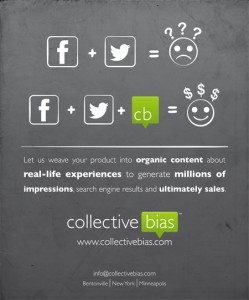The Collective Bias influencer community creates shopper content By Stuart Feil
Septemer 10, 2012 ADWEEK
Shopping is, by its very nature, a social activity—people always want to know what other people are buying or discuss what they’ve bought themselves with friends and other shoppers. Nowhere is this more evident than in the blogosphere, where brand ambassadors (such as the ubiquitous Mom-blogger) share information and advice about what they buy and use. There’s power in this user-generated content, and brands and retailers want to take advantage of these influencers to drive excitement for—and sales of—their products.
 Collective Bias, a Bentonville, AR-based content marketing company, helps brands such as Elmer’s, Starbuck’s, Walgreens and others reach these influencers. It does more than simply connect them. Rather, it has created a proprietary community of more than 1,200 shopping-focused bloggers and other social influencers called Social Fabric, which reaches more than 40 million people and creates more than 200 million monthly impressions.
Collective Bias, a Bentonville, AR-based content marketing company, helps brands such as Elmer’s, Starbuck’s, Walgreens and others reach these influencers. It does more than simply connect them. Rather, it has created a proprietary community of more than 1,200 shopping-focused bloggers and other social influencers called Social Fabric, which reaches more than 40 million people and creates more than 200 million monthly impressions.
The goal: have these bloggers create the kind of authentic, interesting content that amplifies a brand’s attributes and creates deeper relationships between the brand and its buyers. In turn, this social content can be used by brands to glean insight about the shopper’s journey and help them better understand what exactly drives the purchase decision.
As Collective Bias sees it, success in content marketing is often less about buzz and more about relationships. People are looking to brands, retailers and their ambassadors for useful advice that can help them get more out of a product. “Most brands feel if you have something on Facebook and Twitter, it’s social,” says Brad Lawless, the company’s VP of strategy. “But those are just tools. What really matters in social is the relationship you have with people.”
Collective Bias’ model is to maintain a true community for its Social Fabric bloggers and for those bloggers to keep a strong and transparent relationship with their readers. “Real stories about family, budgets, the ease of shopping and incorporating products into someone’s day-to-day life emerge in each program as Collective Bias encourages creativity and integrity,” says Lori Pace of ADayinMotherhood.com and campaign leader for Collective Bias.
But Collective Bias is not looking for a product review from its blogger community. Instead, says Lawless, “We want them to talk about something else and integrate the product into that discussion. It’s the human experience—how certain products can make that better.”
For example, this past summer, Nestlé was looking to create enthusiasm for both Drumstick ice cream and Tombstone pizza brands in its “Grab Summer Fun” promotion at Walmart.
Using Social Fabric, Collective Bias reached members, with the resulting posts incorporating the idea of using pizza and ice cream for “grab and go” summer parties. But each blogger brought a unique spin. One showed a pizza and ice cream party during a family vacation at the beach. Another turned it into a pool party celebrating a toddler’s swim lessons. Yet another made it part of a Fourth of July luau craft project. They also were asked to help promote separate #GrabSummerFun “parties” on Pinterest and Twitter.
Overall, Nestlé saw a double digit increase in net sales of the products. Collective Bias and Nestlé estimate the campaign netted more than 15.8 million impressions for the brands. In addition, it enhanced the search engine optimization for nine different keywords, including “Nestlé Drumstick Ice Cream.” Finally, because the bloggers documented their path to purchase, Collective Bias shared shopper insights, including the number of pizzas each person usually bought and what incidental purchases were made.
This kind of shopper dialogue, notes Lawless, is how content marketing can provide brands with what Ted Rubin, Collective Bias’ chief social marketing officer, calls a “return on relationship.” “They do something that adds value to their lives,” Lawless says. “Our role is about creating connections between brands and their buyers. It’s making them aware of how products are integrated into their lives.”
 -Originally posted at: http://www.adweek.com/sa-article/social-path-purchase-143351#1
-Originally posted at: http://www.adweek.com/sa-article/social-path-purchase-143351#1